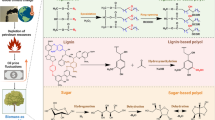Abstract
We recently demonstrated that exposure of synthetic mono-and diunsaturated triacylglycerols to tert-butylhy-droperoxide (TBHP) leads to formation of stable adducts of the oxidizing agent and the unsaturated esters (Sjövall, O., Kuksis, A., and Kallio, H., Reversed Phase High-Performance Liquid Chromatographic Separation of tert-Butyl Hydroperoxide Oxidation Products of Unsaturated Triacylglycerols. J. Chromatogr. A 905, 119–132, 2001). In the present study we isolated and identified the TBHP adducts of corn oil triacylglycerols. The much wider range of molecular species available in the corn oil permitted us to demonstrate that the yield of the adducts varies with the degree of unsaturation of the triacylglycerol. The highest yields were obtained for the linoleate (20% of linoleoyl-containing residual triacylglycerols) and the lowest ones for the oleate (5% of oleoyl-containing residual triacylglycerols) tria-cylglycerols, whereas the saturated triacylglycerols did not give TBHP adducts in readily detectable amounts. Normal-phase thin-layer chromatography along with reversed-phase high-performance liquid chromatography/mass spectrometry (LC/MS) with electrospray ionization was used to isolate and separate the major molecular species of polyunsaturated triacylglycerols and corresponding TBHP adducts. As an extreme example, the dilinoleoylmonooleoylglycerol was identified as the mono-, di-, tri-, tetra-, and penta-TBHP adduct. LC/MS with electrospray ionization at elevated capillary exit voltage (pseudo tandem mass spectrometry) was used to confirm structures of the [M−RCOOH]+ ions and the absence of TBHP adducts of [M−RCOOH]+. It is concluded that stable adduct formation is an unavoidable complication of preparation of oxotriacylglycerols by oxidation with concentrated TBHP solutions and care must be taken to resolve the adducts from the desired oxidation product.
Similar content being viewed by others
Abbreviations
- 16∶0:
-
palmitic acid
- 18∶0:
-
stearic acid
- 18∶1:
-
oleic acid
- 18∶2:
-
linoleic acid
- 18∶3:
-
linolenic acid
- 20∶0:
-
arachidic acid
- CapEx 300:
-
capillary exit voltage of 300 V
- DNPH:
-
2,4-dinitrophenylhydrazine
- ELSD:
-
evaporative light-scattering detector
- ESL:
-
electrospray ionization
- HPLC:
-
high-performance liquid chromatography
- LC:
-
liquid chromatography
- M:
-
molecular ion
- MS:
-
mass spectrometry
- Rt:
-
retention time
- TBHP:
-
tert-butyl hydroperoxide
- TCN:
-
theoretical carbon number
- TLC:
-
thin-layer chromatography
References
Halliwell, B., and Gutteridge, J.M.C. (1990) Lipid Peroxidation: A Radical Chain Reaction, in Free Radicals in Biology and Medicine, 2nd edn, (Halliwell, B., and Gutteridge, J.M.C., eds.), Clarendon Press, Oxford, pp. 189–276.
Porter, N.A., Mills, K.A., and Carter, R.L. (1994) A Mechanistic Study of Oleate Autoxidation: Competing Peroxyl H-Atom Abstraction and Rearrangement, J. Am. Chem. Soc. 116, 6690–6696.
Porter, N.A., Caldwell, S.E., and Mills, K.A. (1995) Mechanisms of Free Radical Oxidation of Unsaturated Lipids, Lipids 30, 277–290.
Kuksis, A., Myher, J.J., Marai, L., and Geher K. (1993) Analyses of Hydroperoxides and Core Aldehydes of Triacylglycerols, in 17th Nordic Lipid Symposium, Lipidforum (Malkki, Y., ed.), pp. 230–238, Bergen, Norway.
Sjövall, O., Kuksis, A., Marai, L., and Myher, J.J. (1997) Elution Factors of Synthetic Oxotriacylglycerols as an Aid in Identification of Peroxidized Natural Triacylglycerols by Reversed-Phase High-Performance Liquid Chromatography with Electrospray Mass Spectrometry, Lipids 32, 1211–1218.
Kamido, H., Kuksis, A., Marai, L., and Myher, J.J. (1993) Identification of Core Aldehydes Among in Vitro Peroxidation Products of Cholesteryl Esters, Lipids 28, 331–336.
Hoppe, G., Ravandi, A., Herrera, D., Kuksis, A., and Hoff, H.F. (1997) Oxidation Products of Cholesteryl Linoleate Are Resistant to Hydrolysis in Macrophages, Form Complexes with Proteins, and Are Present in Human Atherosclerotic Tissue, J. Lipid Res. 38, 1347–1360.
Borowitz, S.M., and Montgomery, C. (1989) The Role of Phospholipase A2 in Microsomal Lipid Peroxidation Induced with t-Butyl Hydroperoxide, Biochem. Biophys. Res. Commun. 158, 1021–1028.
Hall, L.M., and Murphy, R.C. (1998) Analysis of Stable Oxidized Molecular Species of Glycerophospholipids Following Treatment of Red Blood Cell Ghosts with t-Butylhydroperoxide, Anal. Biochem. 258, 184–194.
Sjövall, O., Kuksis, A., and Kallio, H. (2001) Reversed Phase High-Performance Liquid Chromatographic Separation of tert-Butyl Hydroperoxide Oxidation Products of Unsaturated Triacyl-glycerols, J. Chromatogr. A 905, 119–132.
Myher, J.J., Kuksis, A., Ravandi, A., and Cocks, N. (1994) Normal Phase Liquid Chromatography/Mass Spectrometry with Electrospray for Sensitive Detection of Oxygenated Glycerophospholipids, INFORM 5, 478–479.
Frankel, E.N. (1998) Lipid Oxidation, The Oily Press, Dundee, Scotland, pp. 13–22.
Miyashita, K., Hara, N., Fujimoto, K., and Kaneda, T. (1985) Dimers Formed in Oxygenated Methyl Linoleate Hydroperoxides, Lipids 20, 578–587.
Courtneidge, J.L., and Bush, M. (1992) Initiated, tert-Butyl Hydroperoxide-Loaded, Low-Temperature Autoxidation of Alkene: A Chemoselective Synthesis of Allylic Hydroperoxides, Allowing Analysis of the Regioselectivity of Hydrogen Atom Abstraction from Some Unsymmetrically Substituted Substrates, J. Chem. Soc. Perkin Trans. 1, 1531–1538.
Neff, W.E., and Byrdwell, W.C. (1998) Characterization of Model Triacylglycerol (triolein, trilinolein, and trilinolenin) Autoxidation Products via High-Performance Liquid Chromatography Coupled with Atmospheric Pressure Chemical Ionization Mass Spectrometry, J. Chromatogr. A 818, 169–186.
Duffin, K.L., Henion, J.D., and Sieh, J.J. (1991) Electrospray and Tandem Mass Spectrometric Characterization of Acylglycerol Mixtures That Dissolved in Nonpolar Solvents, Anal. Chem. 63, 1781–1788.
MacMillan, D.K., and Murphy, R.C. (1995) Analysis of Lipid Hydroperoxides and Long-Chain Conjugated Keto Acids by Negative Ion Electrospray Mass Spectrometry, J. Am. Soc. Mass Spectrom 6, 1190–1201.
Author information
Authors and Affiliations
Corresponding author
About this article
Cite this article
Sjövall, O., Kuksis, A. & Kallio, H. Analysis of molecular species of peroxide adducts of triacylglycerols following treatment of corn oil with tert-butyl hydroperoxide. Lipids 36, 1347–1356 (2001). https://doi.org/10.1007/s11745-001-0851-0
Received:
Revised:
Accepted:
Issue Date:
DOI: https://doi.org/10.1007/s11745-001-0851-0




